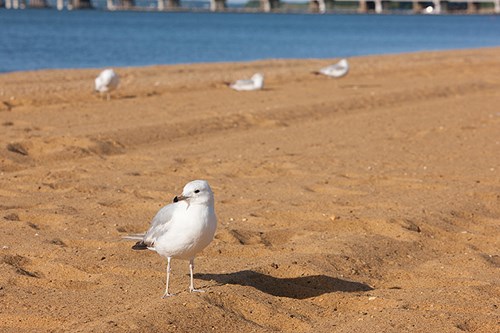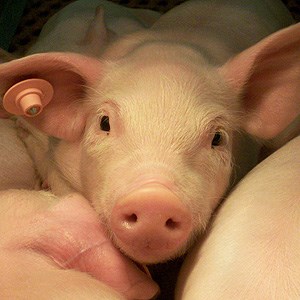An Eye on Animal Influenza and Public Health
Every year, millions of Americans routinely get flu shots to protect against the latest human seasonal influenza virus, which can cause illness, hospitalization, and even death. At the same time, Agricultural Research Service (ARS) scientists are keeping a watchful eye on emerging animal influenza viruses. These viruses pose a public health concern, because they can potentially jump directly from animals to humans and cause serious disease.
A bigger worry is that an animal influenza virus could cause a pandemic outbreak, spreading from person to person around the world, like the pandemic H1N1 virus in 2009. “People don’t have any preexisting immunity to that kind of virus because it’s a completely new infection,” says David Suarez, research leader of the ARS Exotic and Emerging Avian Viral Diseases Research Unit in Athens, Georgia.
Influenza viruses infect many animal species, but of primary concern are viruses that infect swine and poultry. Avian influenza viruses are common in wild birds—such as ducks, geese, swans, and shore birds—but not in U.S. domestic poultry.
 Avian influenza viruses are common in wild birds – such as seagulls, ducks, geese, and swans. (Peggy Greb, D1833-2) |
Scientists are closely monitoring two avian influenza viruses—H5N1 and H7N9—that have been circulating in China for at least two decades. The H5N1 viruses have spread to more than 70 countries and infected more than 500 people, Suarez says. The H7N9 virus is rapidly spreading in China and has already infected more than 800 people. Both influenzas have a high fatality rate in infected individuals.
Adapting to Different Hosts
Influenza A viruses are able to transform themselves into something new to adapt to a new host quickly. “They go through two processes of change in any host,” says Amy Vincent, veterinary medical officer in the ARS Virus and Prion Research Unit in Ames, Iowa. One is gradual, allowing many genetic changes to accumulate over time. The other occurs more rapidly, when a host is infected with two different viruses in the same cell, and gene segments from one virus mix with the other virus’s gene segments. “This new combination could be something the host population isn’t immune to anymore,” Vincent notes.
An example is the H5N1 virus that has been circulating in poultry in China for more than 20 years. It has adapted well to chickens and has produced a lot of variants, Suarez says. Also, “during avian influenza outbreaks in the United States in 2014 and 2015, we saw evidence that an H5N8 was infecting poultry and had mixed with some North American local strains, creating a more infectious and dangerous virus.”
Pigs, Flu, and Fairs
In the United States, most swine viruses identified in people are associated with swine exhibitions at places like county and state fairs. “Most of these swine influenza viruses do not move easily from person to person, which prevents the disease from easily spreading,” Vincent says.
|
|
Infections usually occur in pigs that were probably kept secluded from other pigs and hadn’t been naturally exposed to or vaccinated for flu. “All it takes is one pig to show up with a flu virus, and it’s like a daycare,” Vincent says. “The virus moves through the whole show barn.” For the most part, viruses at fairs are typical of those common in the commercial pig population, she adds.
Occasionally, an avian influenza virus crosses over into pigs. But ARS scientists have found, through surveillance, that human seasonal viruses have had the biggest impact on the evolution of swine influenza in the United States and worldwide.
“In nearly every global region where we have looked, we’re finding that human flu viruses have crossed into pigs,” Vincent says. “It is believed that the H1N1 in 1918, which caused a pandemic, was a human-to-swine event, and it lasted in pigs until the late 1990s.” When a virus is transmitted from humans to animals, it is referred to as a “reverse zoonosis.”
In the late 1990s, a human seasonal virus (H3N2) infected pigs, picked up a couple of genes from avian influenza viruses, and remained a constant presence until the 2009 H1N1 pandemic. “After humans around the world became infected during the pandemic, the 2009 H1N1 influenza virus became a seasonal strain,” Vincent adds. “That strain has maintained its ability to easily infect pigs.” Crossover continues from this and H3N2 human seasonal influenzas into pigs.
Partnering To Address Public Health Concerns
|
|
ARS keeps a close eye on animal influenza outbreaks, working with other countries to obtain viruses in preparation for potential U.S. outbreaks. Suarez and his team ensure that diagnostic tests can identify the virus, and they conduct experiments to discover how the virus affects birds—does it cause any unusual disease symptoms, how long is the incubation period, how transmissible is it, and is it primarily in chickens or does it infect other bird species?
Researchers develop and test available vaccines to see if any are effective against the circulating virus. “We want to provide the poultry industry the best options for vaccination, and that includes understanding what vaccines could be used and which ones shouldn’t be used,” Suarez says.
In addition, ARS works with the Centers for Disease Control and Prevention to evaluate viruses as vaccine candidates against potential pandemic outbreaks. Scientists test vaccine viruses in chickens to ensure that they are safe to use and meet regulatory requirements for registration and market distribution.
Vincent and her colleagues receive and analyze swine influenza viruses from surveillance programs to understand how they are genetically related to what is already in the commercial pig population. They determine whether a virus is new or routine and whether there is a vaccine to protect against it. If a virus is unusual, the scientists study it in pigs.
Vaccines are used to protect pigs against swine influenza in the United States, “but there are so many strains that it is impossible to have one vaccine that covers every type of virus the U.S. pig population is exposed to,” Vincent says.
ARS is also part of a global project, the Centers of Excellence for Influenza Research and Surveillance program—funded by the National Institutes of Health—that conducts research on viruses that might threaten public health. Through this program, Vincent is studying the connection between common swine and human viruses. She is comparing U.S. human vaccine strains from the 1970s to current human and swine strains.
“This allows us to know whether U.S. swine viruses are related to any of the human seasonal viruses,” Vincent says. “It will help predict susceptibility in certain groups of people based on lack of immunity, age, or previous exposure to seasonal human influenza viruses.”—By Sandra Avant, ARS Office of Communications.
Key Facts
- Influenza viruses change quickly to adapt to different hosts.
- Some animal influenza (AI) viruses can infect humans—and vice versa.
- ARS scientists develop AI vaccines to protect against pandemic outbreaks.
- ARS partners with other agencies to closely monitor animal influenza viruses.
Full Story









